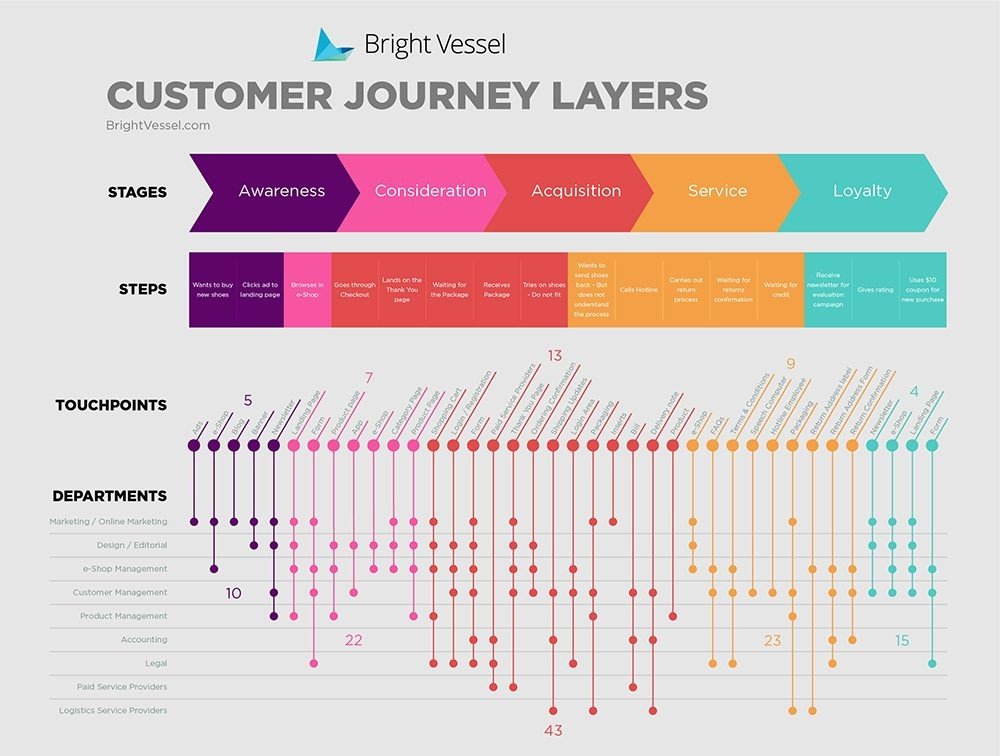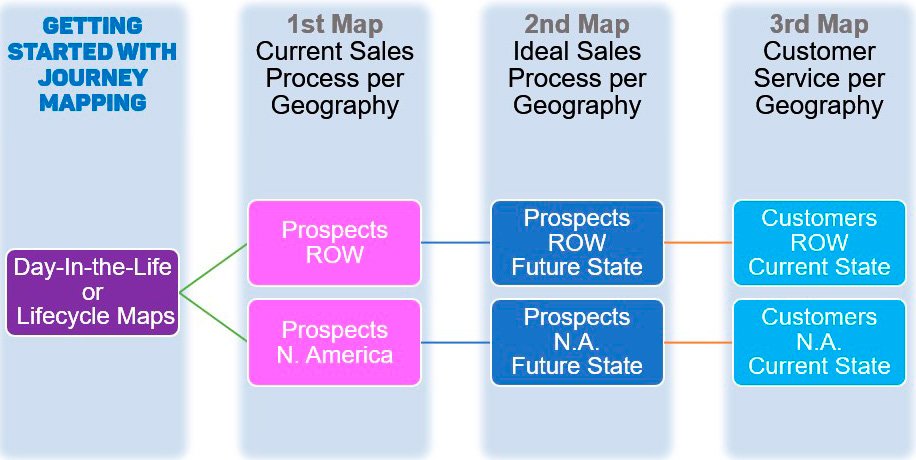That spells opportunity for you.
Forrester Research tells us that 34% of companies use customer journey mapping. That means two out of three competitors do not map out how their marketing and sales works together to win more new business.
Customer journey mapping is a practical but painstaking exercise. You chart each and every impression, touchpoint and interaction with a customer. You study which combination of messages and exchanges yields a sale most efficiently. Lather, rinse and repeat. At the risk of sounding too simplistic, that is customer journey mapping.

Why do customer journey mapping?
The process of customer journey mapping produces a final visual document that shows how customers are won. The buyer is at the top-left: customer journey maps get built from the buyer’s perspective. This is central to the larger concept of being a market-centric company, and any business school professor can lecture you about the virtues of being market-centric.
While this boils down to colorful documents, the goals are financial. The objectives of customer journey maps result in top-line or bottom-line upsides:
- Shorten the sales cycle
- Reduce cost of sales
- Improve customer satisfaction
- Lower customer churn
At least 56% of customer interactions fall into a multi-channel model. Multi-channel means that the stages of selling, delivery and service require several steps and interactions involving two or more devices: the web, email, chat, telephone, face-to-face, and so on. It’s no surprise, then, that identifying operational inefficiencies through journey mapping can lower service costs by 20% or more. The reach goes well beyond the marketing department.
How to create a customer journey map
In customer journey mapping, either the entire journey is laid out or a specific leg. This gets defined by the purpose of the exercise. Investing in a complete lifecycle map for a complex ERP platform may be biting off more than the company can chew. Tackling sales first, on-boarding next, followed by customer support and upselling creates natural phases. Leaders can communicate and implement ideas and outcomes in ways that befit intra-organizational handoffs and various software systems.
For instance, a map may start at the moment an individual (or “prospect”) becomes aware of your brand and continue on past the purchase. Another map may simply begin after a purchase (or trial signup) and help maximize the conversion of new clients from a trial into a subscription. All maps will include multiple touchpoints (or phases) to display how the prospect is interacting with your company and products.

Perhaps the greatest benefit of a customer journey map is its ability to compel employees to understand the customer’s perspective. The facilitator immerses participants in a mapping process that demands focus, focus, focus on the person making the decision and the realities of skipped or duplicate encounters with the brand—not departments, emails and ads. To the customer, it is all one brand regardless of which department was responsible.
Unite IT, Marketing, Sales & Operations
When key managers share a table during a journey mapping session, it is akin to a strategic planning meeting. Managers collaborate to shed light on what really happens in the life of their customer. Like the parable of three blind men reporting on different flanks of an elephant, they identify ways to streamline things on their end—making it easier for the customer in view of what their peers endeavor to do.
The appeal of journey mapping as a team-building, strategic planning experience is its iterative nature. Teams are tasked to make the best of what things are today. Subsequent sessions can tackle ideal future states for a process. New ideas too complex to implement in the first mapping session get saved on the facilitator’s “ideaboard” for use in follow-up sessions.

A company operating differently in North America (N.A.) vs. Rest of the World (ROW) prioritizes what maps it will create. Sales is top priority, so prospecting methods in two different geographies be mapped first. Then, the second session will map an improved future state for sales here and abroad. Next, customer service needs attention, so its current state will be tackled in a third mapping session.
Customer touchpoints
How a telecom provider sells and services a new cell phone customer involves a deceptively complex model. The numbers of ads, personalized appeals and interactions—both online and perhaps at a franchisee’s store—all accumulate and aim to bond with the prospect.

Some models may abbreviate how many touches get made. Each touch may cost money. But the role and the ROI of a bracketed set of touches, such as email blasts, can be evaluated in a sidebar. This demonstrates the flexibility of journey mapping: avoid philosophical exercises, focus instead on key touchpoints that cost a lot of money on the aggregate, make or break a relationship, or both.

Earlier we noted that 2 out of 3 companies don’t do journey mapping. Even fewer do maps of their future state. According to Opinion Lab, just 26% of companies have future state journey maps [Forrester, May 2018]. Is it because they believe their current state is picture perfect? Unlikely. While they may think highly of the current state, they know that technology limitations, budgets and other priorities render future-think irrelevant.
But smaller companies can make hay by leveraging their nimbleness.
Think of a new SaaS company with less than desirable churn rates. The firm’s brilliant product manager finds that customers who use a combination of two specific features within the platform have remained 100% loyal.
Alone, he would need to test this on some customers, create a tutorial, convince and coach marketing and the call center to use the tutorial, then hope customers actual view it based on being told to in a chat or email.
In comparison, by involving others in journey mapping, the product manager engages multiple managers and departments. All disciplines internalize this important new finding about the two killer features. More than an eager marketing coordinator now puts more shoulders to the wheel, finding creative ways to make magic happen and get the message both communicated to and adopted by end-users.
Keywords in customer journey mapping
- Personas: Who you are targeting? Give them a name. Are they more likely to be female? Average age? Where does she live—rent or own? Use demographics and field work to make the data-based buyer into a real human.
- Timeline: If your sales cycle is 9 months to one year, your map may need to be a “Year in the Life,” rather than a “Day in the Life.” In fact, Day in the Life may be said to have limited usefulness—such as isolated experiences, like returning a product. Where buying is an impulse, like retailing, it can be necessary to chart a persona through 3 or 6 months, such as summer, a school term, and a holiday. Only then can an end-to-end experience be drawn toward how to bond with a customer in a lifetime value strategy.
- Touchpoints: Capture and report on each download, outbound call, paid ad campaign, and so on. Paint the whole picture of what it really takes in money, time and effort to win a customer.
- Device: Devices aren’t electronic products. In journey mapping, the device is the email, SMS, the landing page, or the direct outbound call from a rep. Each one of these actions is the device making a touch.
- Emotions: How people feel when interacting or buying is highly subjective. Your team may find themselves energetically debating feelings in the purchasing cycle. And that’s okay.
3 best practices in journey mapping
- Where to begin
Many are tempted to begin with the company’s first communication rather than the customer’s first intent. Do most or all of your customers really arrive in your inbox having the intent to purchase the specific product, color, size, and pricepoint you advertised? Reverse engineer the buyer’s thinking process. Start with her needs, confusion, motivations, and habits.
- Where to end
If your goal is improved sales, understand how you’ll convince prospects to buy and what identify key performance indicators (KPIs) will demonstrate improvement. If the goal is lower churn, is it the quality of the buyers you attract…or the onboarding process? Start with your best hypothesis and go from there. Trial and error is not only okay, it is required.
- Be prepared
Ahead of time, the team should be given a heads-up. Arrive to the meeting with a solid understanding and quick way to reference some data about your customers and segments. Nothing short circuits a customer journey mapping session than not really knowing the customer. If only one person comes prepared, why have a meeting and make that person do all the work, inferences and decision-making? That is, of course, self-defeating.
Ideally, the facilitator of your customer journey mapping has done it before. In fact, that’s an immutable requirement. Really gifted product managers may be able to facilitate—but in a smaller company, that person’s value as a contributor and participant will be compromised if they’re running the show.
Secondly, the facilitator should be just that—someone who remains aloof from drawing conclusions, dictating customer’s attributes, or inflating (or deflating) what sales does with a sales lead. These sessions should be somewhat rapid-fire, engaging, and uplifting.
After all, you get to talk about other people’s feelings, how to make more money, and the best possible ways to treat another human being.
How many of us get to do that for a living?
Companies in the lead fall in love with themselves. They work on improving an aging face in the mirror. They pour massive budgets into one ad over another because a slight difference within 60 characters of text performed three points higher. They write new content today for LinkedIn, making it read like a tweet people liked yesterday on Twitter. They busy their very best people and very real dollars in a solitary game of digital backgammon.



